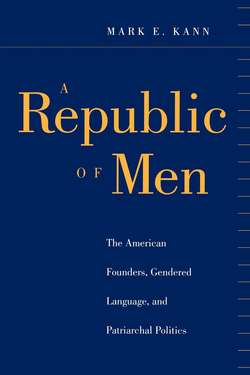A Republic of Men

Реклама. ООО «ЛитРес», ИНН: 7719571260.
Оглавление
Mark E. Kann. A Republic of Men
About NYU Press
A Republic of Men
Contents
Preface
Introduction
1. The Culture of Manhood
The Traditional Patriarch
Destabilizing Traditional Patriarchy
Alternative Ideals
Manhood as an Oppositional Concept
Disorderly Men
The Politics of Coercion and Consent
2. The Grammar of Manhood
Manhood in Time
Manhood and Space
Manhood and Fraternity
Manhood and Leadership
Manhood and the Republic
Order in the Ranks of Men
3. The Bachelor and Other Disorderly Men
The English Bachelor and Redcoat
America’s Vilest Race of Men
The Bachelor within All Men
Other Disorderly Men
Slaveholders and Slaves
The Refuse of the Earth
State Coercion
Marginal Men
4. The Family Man and Citizenship
Better Than Bachelorhood
Provisioning Posterity
Educating Posterity
Protecting Posterity
The Parent and the Patriot
The Limits of Family-Based Citizenship
5. The Better Sort and Leadership
Beyond Basic Membership
The Trustworthy Few
A Man’s Reputation
The Natural Aristocracy
The Rhetoric of Fame and Infamy
Fraternity and Fratricide
One National Brotherhood
6. The Heroic Man and National Destiny
A Few Great Men
Patriarchal Hegemony
Manhood above Public Opinion and Law
Sustaining Hegemony
A Government of Men
7. The Founders’ Gendered Legacy
Durable Manhood
Manhood against Individualism
Manhood and Mortality
Manhood and Civil Society
Manhood and Politics
Remember the Ladies
Notes. NOTES TO THE INTRODUCTION
NOTES TO CHAPTER I
NOTES TO CHAPTER 2
NOTES TO CHAPTER 3
NOTES TO CHAPTER 4
NOTES TO CHAPTER 5
NOTES TO CHAPTER 6
NOTES TO CHAPTER 7
Bibliography. PRIMARY SOURCES
SECONDARY SOURCES
Index
About the Author
Отрывок из книги
Thank you for buying this ebook, published by NYU Press.
Sign up for our e-newsletters to receive information about forthcoming books, special discounts, and more!
.....
Similarly, late-eighteenth-century Americans assessed male worth in opposition to female disorders. Carroll Smith-Rosenberg argues that Americans equated manhood to self-control, productivity, virtue, and independence but linked womanhood (a “negative other”) to seduction, deceit, luxury, and dependence. Linda Kerber dissects Americans’ “gender-specific” citizenship to reveal concepts of ownership, military service, suffrage, and civic virtue that wed public life to male prerogative over disorderly women. Ruth Bloch states that Americans reproduced gender domination by urging patriots to seek manly “glory” and conquer female vices such as “idleness, luxury, dependence.” Philip Greven suggests that Americans construed the Revolution as a choice between republican “manliness” and monarchic “femininity” and, Susan Juster adds, they carried on the Revolution “against, not merely without, women.” Joan Gundersen, Christine Stansell, and Judith Shklar all agree that patriots “heightened and reinforced” their claim to independence by contrasting it to female dependence. Joan Hoff contends that the framers institutionalized male rights, interests, and opportunities in a market society regulated by a “masculine system of justice” and “the masculinity of the Constitution.” Joyce Appleby summarizes the result: “The liberal hero was male.” His proper companion, Jan Lewis concludes, was the “republican wife” who managed her family’s moral reclamation and civic education.34
Scholars of American manhood generally agree that late-eighteenth- and nineteenth-century Americans perpetuated gender opposition. Rotundo identifies the liberal language of the founding era with “the male self,” and Kimmel pinpoints “femininity” as the “negative pole” against which men defined themselves. David Pugh argues that the Sons of Liberty displaced their anxieties onto malignant “female qualities” such as “smothering materialism and effeminate inaction,” while Michael Rogin suggests that the Jacksonian Era’s male mystique was part of men’s struggle “to rescue sons from maternal power.” Joe Dubbert characterizes the nineteenth century as an era when male “domination, supremacy, and control” in public life stood in opposition to women’s moralism in private life. Finally, Kimmel and Peter Filene ascribe a late-nineteenth-century “crisis of masculinity” to male fears that women were making boys effeminate.35
.....